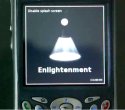E17 adapted to Linux devices, demo’d on Treo650
Oct 15, 2008 — by LinuxDevices Staff — from the LinuxDevices Archive — 4 views Carsten “Rasterman” Haitzler has adapted his Enlightenment window manager to low-powered, small-screen devices like mobile phones. The Linux desktop graphics pioneer has released a pared-down widget set, along with ports and video demonstrations of E17 on OpenMoko's NeoFreerunner phone and Palm's Treo650… (booted into Linux, naturally).
Carsten “Rasterman” Haitzler has adapted his Enlightenment window manager to low-powered, small-screen devices like mobile phones. The Linux desktop graphics pioneer has released a pared-down widget set, along with ports and video demonstrations of E17 on OpenMoko's NeoFreerunner phone and Palm's Treo650… (booted into Linux, naturally).
(Click for larger view of Palm Treo 650 running Linux and E17)
Rasterman's new “Elementary” widget set appears to be a subset of the Enlightment Foundation Libraries (EFL). Rasterman calls Elementary a “hyper-simple-to-use widget set for embedded touchscreen phones,” adding that “It also looks nice and is entirely themeable, etc. But it is very close to the rest of EFL in API,” he writes.
Along with the new “Elementary” widget set, improvements to the illume plugin also facilitated the newly available Treo650 and Neo Freerunner ports, Rasterman says. Illume is an Enlightenment plugin that adds small-screen support. “This shows just how flexible the scheme is that E can morph into a GUI for tiny touch-screen embedded devices just with a module addition,” Rasterman writes.







Illume screenshots
(Click any to enlarge)
Once upon a time, in pre-GNOME days, Enlightenment was actually considered to be a “heavy” window manager. For a time the default Red Hat window manager, it notably brought support for transparent windows and other eye candy to the Linux desktop for the first time.
With the march of time and processor power, the current Enlightement 0.17 release, aka “E17,” has come to be considered a lightweight alternative to GNOME and KDE, used for example in gOS 3.0 , a commercial Linux distribution aimed at “low-powered” netbooks. Yet, it appears that E17 could be primed for a renaissance of relevance in even smaller devices.
According to the Rasterman, when used with his updated illume stack and new Elementary widget set, E17 can now run in just 32MB of RAM, on an ARM9 processor clocked at 317MHz. To prove it, he is distributing a Linux kernel and E17/Illume/Elementary stack for Palm's Treo650. The stack can be launched from PalmOS without touching the device's flash storage, he says.
Also available is a video showing off the port, as well as an E17 port and video of E17 on the more powerful OpenMoko NeoFreerunner (which has 128MB of RAM, and a 400MHz processor).
What's behind these latest surges of Enlightment productivity? The Rasterman reveals that he has been working to help Swisscom, a Swiss network provider interested in “proving that an open Linux platform for phones is a viable thing that gives network operators [and users] more freedom and power.” Rasterman explains, “I won't go into their plans any more than that, but one thing they do want is a great looking toolkit that makes it trivial to write GUI apps for open phones. To that extent I started Elementary and have polished up Illume just a little (but it definitely needs more work).”
Additionally, Rasterman was named lead graphics architect earlier this year by OpenMoko, an FIC spin-out that sells open hardware designs and supports OpenMoko.org, a group working to build an open source Linux mobile phone software stack.
More details about the new project and ports can be found in the Rasterman's homepage, here.
This article was originally published on LinuxDevices.com and has been donated to the open source community by QuinStreet Inc. Please visit LinuxToday.com for up-to-date news and articles about Linux and open source.